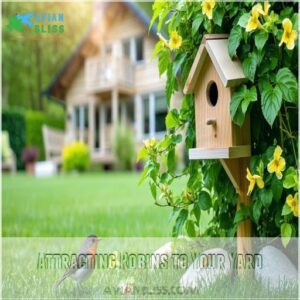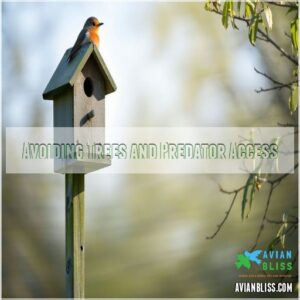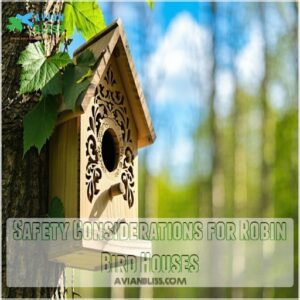This site is supported by our readers. We may earn a commission, at no cost to you, if you purchase through links.

Proper ventilation and drainage holes are non-negotiable—think of them as a bird’s version of climate control. Mount the birdhouse on a building or under an eave to deter predators, and keep it off trees (squirrels aren’t welcome house guests).
Regularly clean and repair the birdhouse to create a cozy, inviting spot. Add a nearby birdbath or mealworms to sweeten the deal—robins love a backyard that feels like home.
Curious about placement specifics? Read on!
Table Of Contents
- Key Takeaways
- Choosing The Right Birdhouse for Robins
- Designing and Building a Robin Bird House
- Installing and Maintaining a Robin House
- Attracting Robins to Your Yard
- Top 8 Bird Houses for Robins
- Where to Place a Robin Birdhouse
- When to Put Up a Robin Birdhouse
- How to Keep Robins in a Birdhouse
- Safety Considerations for Robin Bird Houses
- Robin Nesting Behavior and Habitat
- Frequently Asked Questions (FAQs)
- What are the best robin bird house plans?
- Do Robins need a birdhouse?
- Where do robins nest in a birdhouse?
- What Birdhouse is best for Robins?
- Are bird houses safe for Robins?
- How do you keep Robins in a birdhouse?
- Do robins use birdhouses?
- What is the best house for a robin?
- Where do you put a birdhouse for a robin?
- What size bird house for robins?
- Conclusion
Key Takeaways
- Build robin birdhouses with a spacious 8"x8" open-front design using untreated cedar, ensuring proper drainage and ventilation.
- Mount the birdhouse under eaves or on buildings, away from predators like squirrels and cats, and avoid trees for safety.
- Keep the birdhouse clean and repair it regularly to maintain a safe, inviting space for robins.
- Attract robins further by offering nearby water sources like birdbaths and food such as mealworms or berries.
Choosing The Right Birdhouse for Robins
You’ll need a birdhouse with specific measurements to attract robins: a 6×6-inch floor space and a 2-2.5-inch entrance hole are essential for these cheerful spring visitors.
Your choice of untreated wood material, proper ventilation, and strategic drainage holes will create the perfect haven that keeps your feathered friends comfortable and safe.
Size of The Interior Floor Space
Regarding robin bird houses, optimal floor space matters. A roomy interior measuring 8" x 8" provides the ideal nesting area for robins, aligning with their natural preferences.
These floor space requirements create enough room for a growing family while ensuring comfort.
By measuring birdhouse capacity carefully, you’ll build backyard robin houses that truly attract robins.
For more specific requirements and dimensions for various bird species, consult a Bird House Dimensions Chart.
Entrance Hole Diameter
After ensuring enough floor space, let’s talk entrance hole safety.
For robin bird houses, skip the circular openings typical in other designs. Robins prefer an open-front roosting entrance for nesting access, accommodating their needs while keeping predators out.
This preference is essential for their nighttime roosting habits, as they often sleep in Communal Roosts. These hole size variations create a welcoming yet secure space for robins nesting in boxes, enhancing their backyard stay.
Materials Used
A great wooden robin house starts with the right materials. Use durable cedar wood or cedar fence pickets for longevity.
Pick natural fibers and sustainably sourced wood to keep things eco-friendly. Avoid treated wood; stick to recycled materials when possible.
If painting, go for eco-friendly paints that won’t harm robins, ensuring your cedar birdhouse plans blend safety with durability.
For more information on selecting the ideal materials, consider consulting an in-depth guide to building robin birdhouses.
Ventilation and Drainage
Ventilation and drainage keep a birdhouse livable.
Airflow systems and drainage holes are essential components of a well-designed birdhouse. Add soffit vents or small gaps beneath the roof for airflow systems.
Drainage holes in the floor prevent water pooling and mold growth.
Roof overhangs and gutter installations protect from rain.
Here’s a quick guide:
| Feature | Purpose | Example |
|---|---|---|
| Soffit Vents | Air circulation | Prevents overheating |
| Drainage Holes | Moisture control | Avoids puddling |
| Roof Overhang/Gutter | Rain protection | Shields nest interior |
Designing and Building a Robin Bird House
Building a robin bird house isn’t complicated if you follow a thoughtful design that prioritizes space, airflow, and drainage.
With simple tools and a cedar fence picket, you can create a durable structure that meets a robin’s nesting needs, providing the necessary space for a comfortable living environment.
Using Cedar Fence Pickets
Cedar fence pickets are a top choice for building robin houses due to their durability and resistance to decay. Here’s how to use them:
- Choose untreated cedar pickets for safety.
- Cut pickets to size using woodworking tool essentials.
- Edge-glue boards for sturdy joins.
- Explore recycling fence pickets for eco-friendly options.
- Consider treatment options to enhance longevity, and find available cedar products that suit your project needs.
Assembling The Floor, Sides, and Roof
Once your cedar planks are cut, start with the floor construction, securing it with nails and construction adhesive for sturdiness. Add the sides next, verifying precise nail placement to prevent splitting. Complete the roof assembly by angling the pieces for water runoff.
Consider exploring pre-made cedar birdhouse kits for a simpler DIY approach. Stick to robin birdhouse plans, prioritizing durability and simplicity for your DIY robin birdhouse.
| Step | Materials Needed | Key Tip |
|---|---|---|
| Floor | Cedar, Nails, Adhesive | Verify tight joints. |
| Sides | Cedar, Hammer, Adhesive | Check alignment frequently. |
| Roof | Cedar, Saw, Adhesive, Nails | Angle for rain drainage. |
Attaching The Back to The Robin House
Align the back panel carefully with the sides and roof, making certain a snug fit in your robin birdhouse plans.
Use secure fastening methods like screws or nails—avoid relying solely on wood glue alternatives. Add weatherproofing seals to protect against rain and corner reinforcement for stability.
This step guarantees the birdhouse for robins remains durable and inviting for nesting.
To further support these birds, consider incorporating eco-friendly choices, such as durable materials like cedar, in your birdhouse design to ensure a safe and supportive environment.
Installing and Maintaining a Robin House
When installing a robin house, place it on the side of a building or under an eave, steering clear of trees to keep predators at bay.
To maintain it, clean the house twice a year and repair any damage promptly to guarantee it remains a safe and welcoming space for robins.
Installing on Sides of Buildings or Under Eves
When installing a birdhouse for robins, focus on sturdy spots like building sides or under eaves.
These areas offer shelter and visibility for robins. For best results, use secure screws and verify the structure is level.
Eave installation tips include considering siding material options and avoiding damage.
Robin nesting boxes thrive here, blending safety with practicality while deterring predators naturally.
Avoiding Trees to Prevent Predator Access
To keep robins safe, skip trees for mounting birdhouses. Predators like cats and squirrels see those branches as highways, not barriers.
Instead, try placing birdhouses on:
- Poles, ensuring they’re sturdy and predator-proof.
- Fences, offering height and stability.
- Walls under eaves, shielding from wind and rain.
These methods create urban robin habitats while enhancing backyard security measures.
Regular Cleaning and Timely Repairs
Keeping birdhouses for robins clean guarantees happy tenants and boosts nesting box durability.
Seasonal maintenance is simple: clear old nests and use mild soap to remove dirt.
Regular birdhouse cleaning minimizes disease, while quick birdhouse repairs with quality materials extend lifespan.
Staying on top of birdhouse maintenance keeps robins nesting comfortably—and you’ll enjoy their visits for years with happy tenants and a longer nesting box durability.
Attracting Robins to Your Yard
Attracting robins to your yard requires providing essential resources like food, water, and safe nesting materials.
By creating a balanced environment with accessibility for the birds and protection from predators, you can encourage these cheerful visitors to settle and thrive.
Providing The Right Food and Nesting Materials
What do robins really need to thrive in your yard? Start with food variety options that meet their dietary needs:
- Mealworms (packed with protein).
- Suet or bird seed blends.
- Crushed peanuts and raisins.
- Backyard foraging spots for worms and berries.
- Mud puddles for nesting.
A well-stocked Robin Bird Feeders can help supplement their diet and attract them to your yard.
Sprinkle in nesting materials like moss, feathers, or leaves for the perfect setup!
Offering a Source of Water
A clean water source is irresistible to robins.
Add a birdbath or mud puddles to your yard, ensuring rain protection and freshness. Choose easy-to-maintain water features and garden irrigation systems to keep water flowing.
Use the table below for ideas:
| Option | Maintenance Needed | Robins Attracted? |
|---|---|---|
| Simple Birdbath | Low | Yes |
| Mud Puddles | None | Yes |
| Small Pond | Moderate | High |
| Fountain Feature | High | Yes |
| DIY Water Dish | Low | Moderate |
Creating a Delicate Balance Between Accessibility and Security
A robin bird home needs the perfect mix of security and access.
Choose a nesting site with a clear view, making it easier for robins to spot predators.
Use secure entrance designs and predator deterrent systems like smooth surfaces to keep threats at bay.
Balancing safety and accessibility guarantees robins feel welcome in their bird houses for robins.
Top 8 Bird Houses for Robins
You’ve got plenty of options regarding finding the best birdhouses for robins, but not all designs meet their unique nesting needs.
Here are eight expertly reviewed birdhouses that provide the perfect balance of safety, comfort, and functionality for attracting robins to your outdoor space.
1. Gorilla Clear Construction Adhesive

Gorilla Clear Construction Adhesive isn’t your average glue—it’s a game-changer for birdhouse assembly.
Its incredible 2X strength guarantees your robin house can handle all weather conditions while staying rock-solid.
It bonds like a champ to cedar, fiberglass, and other materials, making it perfect for securing nesting shelves or repairs.
Plus, it dries crystal clear, so you don’t sacrifice looks for durability.
With a quick 15-20 minute set time and gap-filling ability, your project stays sturdy and seamless.
Robins will thank you for using Gorilla Clear Construction Adhesive.
Best For: DIYers, handymen, and hobbyists needing a strong, waterproof adhesive for indoor and outdoor projects across multiple materials.
- Crystal clear finish and 100% waterproof, even under water.
- Strong bond for versatile materials like wood, glass, ceramic, and stone.
- Repositionable, gap-filling, and paintable for seamless, flexible applications.
- Stickiness makes it tricky to work with without proper tools or gloves.
- Prolonged UV exposure may reduce clarity and flexibility over time.
- Requires a caulking gun for use, which might be an extra purchase for some.
2. Cedar Birdhouse Nesting Box Feeder
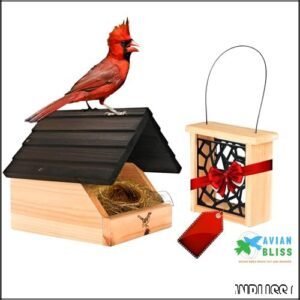
The Cedar Birdhouse Nesting Box Feeder combines durability and thoughtful design, making it perfect for robins. Crafted from long-lasting cedar, it features an open-front design that mirrors robins’ natural nesting preferences.
With pre-drilled holes and included screws, assembly and installation are simple. Its spacious 8"x8"x8" dimensions offer plenty of room for nesting.
Robins will appreciate the perch for surveying their surroundings, adding to its appeal. The birdhouse is also durable and easy to maintain, making it a practical option.
It’s a reliable option for anyone looking to welcome robins into their yard.
Best For: Homeowners or bird enthusiasts looking to attract robins, doves, and other garden bird species with a durable and easy-to-install nesting option.
- Made from durable cedar wood for weather resistance and long-term use.
- Easy to install with pre-drilled holes, screws, and mounting hardware included.
- Spacious design with a perch suitable for multiple bird species.
- Lacks detailed assembly instructions, which may be challenging for first-time users.
- Paint imperfections and occasional splinters reported by some customers.
- Suet cake feeder can be tricky to clean and may not stay securely in place.
3. Navaris Wooden Bird Nesting Box
 View On Amazon
View On Amazon Navaris Wooden Bird Nesting Box is a great pick for robins and other small birds.
Built with sturdy pine wood, it’s ready to hang and features an open-front design, making it easier for birds to access and for you to observe their natural behavior.
Its compact size blends well in gardens or on posts but might be a bit small for larger robins.
Durable and affordable, it’s a solid choice for attracting feathered friends while adding charm to your outdoor space.
Best For: Bird enthusiasts looking to attract and observe small bird species like robins, hummingbirds, or bluebirds in their outdoor spaces.
- Made of sturdy pine wood, providing durability and a natural look.
- Pre-assembled with a pre-drilled hole for easy hanging and installation.
- Compact and lightweight, fitting well in gardens or on trees.
- May not accommodate larger birds or those with specific nesting needs.
- Rough edges or splinters might require some sanding or finishing.
- Mixed success reported in attracting birds, depending on location and placement.
4. Wild Bird House for Garden
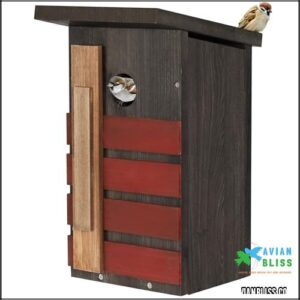
A Wild Bird House for your garden brings charm and practicality, offering robins a cozy, weather-protected shelter.
Made from sturdy wood, it’s easy to hang on fences, trees, or canopies, though tweaking assembly might be needed.
A sloping roof shields against rain, while additional ventilation guarantees comfort during warmer months.
Its spacious interior suits various birds, and a cleaning door simplifies maintenance.
Consider positioning it to avoid strong winds and predators while getting a perfect spot for observing nature’s little joys, such as watching the birds from a Wild Bird House.
Best For: Bird enthusiasts looking to attract and provide shelter for small wild and garden birds.
- Durable natural wood construction with an attractive design.
- Easy to position on trees, fences, or canopies.
- Cleaning door simplifies maintenance.
- Assembly instructions may be unclear or incomplete.
- May require additional tools or design modifications for optimal use.
- Potential need for extra ventilation or light-colored paint to prevent overheating.
5. Robin Nesting Box by Esschert
Robins will feel right at home with the Esschert Robin Nesting Box. Made of sturdy pinewood and topped with a durable metal roof, it’s built to handle the elements while offering a cozy nesting spot.
No assembly is required, saving you time. Hang it at least 6 feet off the ground in a shaded, quiet spot to give robins the perfect haven.
Cleaning is a breeze—just use warm water and a brush. It’s a solid choice for nature lovers!
Best For: Anyone looking to attract robins and other small wild birds to their garden with a low-maintenance, durable nesting box.
- Made with durable wood and a metal roof to withstand the elements.
- Easy to install with no assembly required.
- Simple to clean with just warm water and a brush.
- Some customers reported receiving damaged products upon delivery.
- Requires specific placement and conditions to attract robins effectively.
- May need additional treatment to protect the wood from rain and insects over time.
6. Small Hanging Bird House Gift
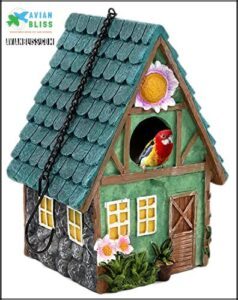
This charming Small Hanging Bird House Gift is perfect for robins seeking comfort and security.
Made of durable resin and hand-painted for a unique touch, it’s as much a decoration as it’s a cozy shelter.
Lightweight and easy to hang, it features a 5-inch chain and a cleanable interior.
While it may be smaller than expected for some, its warmth and bird-friendly design make it a thoughtful addition to any yard.
Plus, it’s an excellent gift for nature enthusiasts.
Best For: Bird lovers looking to add a charming and functional small birdhouse to their outdoor or indoor decor.
- Hand-painted and uniquely crafted for an eye-catching design.
- Durable resin material that’s lightweight and easy to hang.
- Features a cleanable interior for convenience.
- Smaller size than some customers may expect.
- May have a lingering odor for certain buyers.
- Limited to small bird species only.
7. JC Wildlife Modern Cedar Robin Roosting Platform
Crafted with care, the JC Wildlife Modern Cedar Robin Roosting Platform blends durability and eco-friendliness.
Made from clear cedar and recycled poly lumber, it won’t crack, split, or fade. Its open design simplifies cleaning, while the pre-drilled mounting holes make installation a breeze.
Perfect for robins, doves, or swallows, this platform is handmade in Southern Indiana. The design offers birds a safe and welcoming space, available in vibrant colors like blue, green, and red.
It’s functional, stylish, and built to last!
Best For: Nature lovers looking for a durable, eco-friendly roosting platform that’s easy to maintain and ideal for robins, doves, and swallows.
- Made with eco-friendly materials that resist cracking, splitting, and fading.
- Easy to install with pre-drilled holes and an open design for low-maintenance cleaning.
- Aesthetic and functional design available in vibrant colors to enhance outdoor spaces.
- Limited size may not be suitable for larger bird species.
- Only available in specific color options, which may not suit all preferences.
- Requires a proper outdoor mounting location to ensure usability.
8. Cedar Modern Robin Nesting Platform

The Cedar Modern Robin Nesting Platform combines style and practicality, creating a cozy haven for robins.
Made from sturdy cedar and eco-friendly recycled poly lumber, it’s built to last without cracking or fading. Its open design invites robins to nest and also makes cleaning effortless.
Pre-drilled holes simplify installation, ensuring it’s up in no time. With dimensions of 8" W x 11.75" H x 8.5" D, it’s perfectly sized.
This functional, durable platform suits any bird-friendly backyard, providing a cozy haven for its inhabitants.
Best For: Homeowners looking for a durable, eco-friendly nesting platform for robins and other small birds.
- Made from eco-friendly and durable materials, guaranteed not to crack, split, or fade.
- Easy to install with pre-drilled mounting holes and simple to clean with an open design.
- Attractive and functional design that suits bird-friendly backyards.
- May require additional installation materials like heavy-duty Velcro.
- Some customers reported challenges with refunds and restocking fees.
- Not all customers experienced successful nesting by birds.
Where to Place a Robin Birdhouse
Placing a robin birdhouse in the right location is critical to keeping the birds safe and encouraging nesting.
Avoid trees to protect against predators, and choose spots with a wide-open view so robins can easily scout for food and threats.
Avoiding Trees and Predator Access
Placing a robin birdhouse in tree-free zones helps with predator control and guarantees safe perches.
Trees often attract predators like cats or squirrels, so elevated nesting on a pole, fence, or under eaves provides secure installations.
Proper wind protection adds safety.
By avoiding tree placement, you’re offering a sanctuary robins can trust—free from threat, secure, and welcoming.
Providing a Wide-Open View
How do you choose the best spot for a robin bird home?
Open space requirements are key—robins love clear surroundings and a wide field of vision.
Install your robin nesting house in areas with minimal obstructions to enhance landscape visibility.
This setup aids their natural need for constant visual surveillance, creating an ideal robin bird habitat for nesting and feeding.
When to Put Up a Robin Birdhouse
You should put up a robin birdhouse between September and March to guarantee it’s ready before breeding season starts in April.
This timing gives robins ample opportunity to locate and settle into their new nesting spot.
Installing From September Through March
Robins nesting habits align perfectly with starting from September to March. Think of it as prepping your guest room before spring visitors arrive.
Off season maintenance guarantees the birdhouse is clean and safe, while accounting for robins migration patterns, which mirror those of males in partially migratory populations, as described in female robin migration.
Winter birdhouse care protects it from damage, so you’re ready when robin nesting season, marked by their cheery behavior patterns, begins.
How to Keep Robins in a Birdhouse
To keep robins in a birdhouse, provide a safe, well-placed shelter that mimics their natural nesting conditions.
Make sure the space is secure from predators and encourages their instinctive behaviors for raising young.
Providing a Safe and Secure Environment
To keep bird houses for robins safe, focus on predator deterrent systems like baffles or smooth poles.
Verify insulation in robin nesting box plans to shield eggs from extreme temperatures.
Install shelters in low-traffic zones using safe installation practices. Regular maintenance prevents rot, stabilizing robin nesting sites.
Address environmental factors like rain by adding drainage to your robin bird shelter to prevent damage from extreme temperatures.
Promoting Natural Behavior
Encouraging natural behavior means respecting robin instincts.
Place robins’ bird houses where they can freely observe their surroundings, mimicking their wild nesting site selection.
Add environmental enrichment, like soft nesting materials nearby, to spur behavioral adaptation.
Supporting bird socialization through proximity to water and food helps to make them feel safe while their robin bird shelter seamlessly integrates with nature.
Allowing for Observation of Natural Bird Behavior
Get closer to nature by observing robins in action.
Install a birdhouse camera for an up-close Robin Behavior Study or practice Bird Watching Techniques with binoculars nearby.
Keep your setup subtle to avoid disturbing nesting patterns.
Watching robins care for their young connects you to their world, while inspiring bird-friendly yards and fostering robin bird conservation efforts.
Safety Considerations for Robin Bird Houses
When building a robin birdhouse, it’s essential to prioritize safety by keeping predators out and ensuring the structure supports the birds’ needs.
Proper drainage, well-placed entrances, and predator deterrents help create a secure environment for robins to thrive, ensuring the structure supports the birds’ needs through proper drainage.
Deterrents for Unwanted Visitors
Keeping robins safe starts with stopping invaders.
Try these steps:
- Install Predator Guard Systems to block squirrels and raccoons.
- Use Birdhouse Camouflage Techniques, like blending with surroundings, to mislead predators.
- Keep Unwanted Nesting Species out using smaller entry holes or adjustable plates.
These tricks protect robins, promote bird conservation, and even offer natural pest control for your yard!
Ensuring Easy Access for Robins
Robins prefer bird houses they can enter with ease. Accessible Entrance Design paired with easy landing surfaces makes their approach smooth.
Position the nesting shelf at a shallow depth for simple access.
When choosing Birdhouse Mounting Options, verify stability and proper height.
Robins are attracted to bird-friendly environments with Native Plants and Food Sources.
Robin Entrance Placement matters—robins bird houses should mimic natural ledges they instinctively trust.
Preventing Rainwater Accumulation
A well-thought-out robin birdhouse design protects against rain. Add a slight roof tilt and small drainage holes in the base to guarantee water escapes quickly.
For extra waterproofing, consider a basic gutter installation along the edges. Good ventilation design keeps the interior dry, while precise birdhouse plans for robins—like proper roof drainage systems—prevent soggy nests.
Robin Nesting Behavior and Habitat
Robins are selective about their nesting sites, favoring areas that combine safety with easy access.
Understanding their territorial habits and preference for open nesting shelves helps you create a welcoming and functional habitat.
Natural Nesting Sites
In the context of natural nesting sites, robins are resourceful birds.
They often choose sites that offer protection from harsh weather and predators, such as tree branches, ledges, eaves, window sills, and even rocky outcroppings or ground cavities.
Brush piles, shrubs, and vegetation provide shelter and natural insect control, making them ideal spots.
Territorial Behavior and Nesting Shelves
Understanding robin territoriality is key when placing nesting shelves. Robins fiercely guard boundaries, making proper nesting shelf placement essential—keep shelves 65 feet apart.
Their dominance hierarchy thrives on clear boundary establishment, so avoid overcrowding.
A well-placed robin nesting shelf, built with an open design, mimics natural sites, supporting nest site selection and safe robin bird nesting. Protect these spaces from predators.
Frequently Asked Questions (FAQs)
What are the best robin bird house plans?
Building a robin birdhouse is like crafting a cozy nook. Use cedar wood, keep an open-front design, and make sure of proper ventilation.
Install it under eaves or on posts, away from predators, for happy nesting.
Do Robins need a birdhouse?
Robins don’t need traditional birdhouses.
They prefer open-front nest shelves or natural ledges.
Provide a flat surface under an eave or on a post, and you’ll likely welcome these cheery birds into your backyard.
Where do robins nest in a birdhouse?
You’ll find robins nesting on open-front birdhouses or flat nesting shelves.
They prefer these structures under eaves or on walls with clear views, giving them space to monitor surroundings and access food while feeling secure.
What Birdhouse is best for Robins?
Choose a birdhouse with an open front, durable cedar construction, and a 6×6-inch floor.
Verify that it has ventilation, drainage, and easy cleaning access.
Place it in a secure, open spot for successful nesting outcomes.
Are bird houses safe for Robins?
Ever wondered if birdhouses truly protect robins?
Properly designed ones, with open fronts, ventilation, and predator-safe placement, are safe.
They provide shelter for nesting while allowing robins to thrive naturally in your backyard.
How do you keep Robins in a birdhouse?
Place the birdhouse in a sheltered, quiet spot with open visibility.
Keep it clean, offer nearby water, and provide soft nesting materials like grass or twigs.
Avoid heavy foot traffic to guarantee robins feel secure.
Do robins use birdhouses?
Home is where the heart is," but robins rarely use traditional birdhouses.
They prefer open-front nesting shelves or ledges that mimic natural sites, like branches or eaves, offering safety, visibility, and easy access for their families.
What is the best house for a robin?
The best robin house is an open-front nesting shelf, ideally made from cedar for durability.
Mount it 5-25 feet high under eaves or on walls, ensuring ventilation, drainage, and spacing to suit territorial robins.
Where do you put a birdhouse for a robin?
Place your robin birdhouse 5-25 feet high on a building’s side, under eaves, or on a sturdy post.
Avoid trees to deter predators,
and guarantee it offers a clear view of open yard space.
What size bird house for robins?
Think of cozy bird real estate—robins love an open-front “apartment” with at least 6×6 inches of floor space and a 7-inch depth.
Keep it welcoming with natural, untreated wood and good ventilation.
Conclusion
Creating cozy, comfortable bird houses for robins guarantees these delightful birds feel secure and welcomed in your yard.
By prioritizing proper placement, durable materials, and open designs, you’ll offer an ideal nesting spot that mimics their natural habitat.
Don’t forget to pair the birdhouse with fresh water and food to keep them coming back to create a robin haven, blending beauty with biodiversity for years to come.
- https://70birds.com/bird-species/american-robin/
- https://www.birdhouses101.com/bird-species/robin/building-a-birdhouse-for-the-robin/
- https://www.birdsandblooms.com/birding/attracting-birds/bird-nesting/robin-bird-house/
- https://growitbuildit.com/birdhouse-robin-bird-nest-box-shelf-step-by-step-guide/
- https://www.birdwatching-bliss.com/bird-house-dimensions.html






